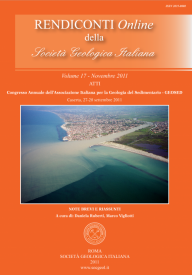
Stratigraphy of the subsurface of the Metaponto Plain vs a geophysical 3D view of the late Pleistocene incised-valleys (Basilicata, Southern Italy)
Tropeano M. (*), Cilumbriello A. (*), Grippa A. (*), Sabato L. (*), Bianca M. (**), Gallicchio S. (*), Gallipoli M.R. (***) & Mucciarelli M. (**)
(*) Dipartimento di Scienze della Terra e GeoAmbientali, Università degli Studi di Bari "Aldo Moro", 70125 Bari, Italy. E-mail: m.tropeano@geo.uniba.it
(**) Dipartimento di Strutture, Geotecnica, Geologia Applicata all'Ingegneria, Università degli Studi della Basilicata, Potenza, Italy.
(***) IMAA-CNR, Tito Scalo (PZ), Italy.
Volume: 17/2011
Pages: 187-193
Abstract
The stratigraphical analysis of several boreholes drilled in the Metaponto coastal plain (Basilicata region, southern Italy) highlighted the occurrence of two irregular erosional surfaces bounding three main overlapping sedimentary units. The upper unit, which base has been detected by using a geophysical method for the H/V spectral ratio (HVSR) of microtremors, fills and covers some paleovalleys that were incised during the Last Glacial Maximum (LGM). A 3D view of a main geophysical unconformity shows a surface with the occurrence of some deeper, narrow, and sinuous zones running roughly perpendicular to the present-day coastline and at depths of up to 90 m below the present-day sea level. These narrows likely correspond to the paleovalleys that developed in the region during the LGM and are buried below the Metaponto coastal plain. Some discrepancies between the geophysical and the geological data may be explained either as induced by a not well constrained projections of boreholes (from which derive the lithostratigraphic interpretations) or considering that the sedimentary models of incised-valley fills suggest the presence of different coeval deposits along dip through paleovalleys, inducing a contrast of seismic impedance readable as paleotopography rises.
Keywords
incised-valley fill, late Pleistocene-Holocene, Metaponto Plain subsurface, Basilicata, Southern Italy
Get Full Text